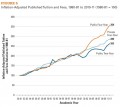Why are College Students in Debt?

It is well known that college education is expensive. However, apart from the tuition and the other educational expenses, it has been found that most of the students spend lavishly on unnecessary and superficial things that go on to burden most of the students with huge debts. The economic realities of the costs of a college education were highlighted in “Business Week” magazine under the title, “Thirty & Broke, the Real Price of a College Education Today,” datelined November 14, 2005. The findings of this article reveal that indebtedness is growing among the students over the years. For instance, in 1992-93, 24.8 students earning degree at a public college graduated with debt. In 2003-2004, 58 percent students from a public college graduated with debt. The median amount of these indebted students in 1992-93 was $8,226, while the same in 2003-2004 was $14,671. The figures, both for the percentage of students that were in debt and the median amount, were considerably higher for students studying in private college (ebsco.com). The question to be asked is “"Why do college students accumulate so much debt during college and how does it impact their future?” Student debt is the effect with a large number of consequences, while the student debt itself could be the result of a large number of causes. We shall in this paper examine the causes leading to student debt, and also briefly discuss the impact of student debt. In any causal relationship, a cause leads to an effect, which is itself the cause of further effect.
Gen Xers are the first generation graduate students to pass out of college with significant student debts. Nine out of ten consumers in their 30s are in debt as against 76 percent in their 20s. Among those in 30s, twenty percent are still paying their college loan with mean balance upward of $13,000. While the Gen Xers are in the unfortunate situation of not only having to pay their college debt but also to keep aside savings for retirement as well as for college savings of their children.
It is easy to infer the reasons for debt among students and young professionals from the article “Debt-squeezed Gen X saves little” datelined May 20, 2008 published in USA Today . According this article, men in their 30s earn 12 percent less in comparison to the income of their dads, three decades earlier, when adjusted for inflation. Also, the family income declined just as most of the Gen X entered the work force because pay had risen steadily around this time primarily due to women entering the work force in large numbers. Moreover, the Gen X had the unfortunate experience of becoming adults at a time when the expenses on the essential needs such as home, health, insurance and cars rose steeply.
For college students nothing is easier than accumulating debt in their college years. While the credit card issuers lavish the students with freebies as baits to lure them in, the students may not find difficult to indulge lavishly with credit cards in their pockets. The credit cards should be used with great responsibility. The young students in college or at least a majority of them may not use the level of prudence and maturity required to handle a credit card responsibly. Here’s the case study that highlights how students in college indulge in excessive expenses on their credit cards. Bielagus had eight credit cards while studying in the University of Miami. He accumulated a debt of $5000 during his early years in college. He went out to eat five nights a week, while his campus job paid $6 an hour. Over and above, vacations and weekend trips added to his already bulging debt. Although, Bielagus managed to clear off his debts, this is not the case with most other students who fail to retire off their credit card debts even after graduating and joining the work force.
The implications of accumulating debts adversely impacts students. They may have to enter work for with a poor credit history and in extreme cases they may have to even shelve their plans of higher studies due to the mounting expenses compounded with unpaid past debts. The result of repaying higher loan amounts, for instance, in 1987, 11 percent students had to alter their career plans, while the figure for the same rose to 17 percent in 2002. Similarly, many graduates entering the work force have to delay the purchase of a house, delay getting married, and delay having children, since they are forced to pay higher loan amounts.
College debts are the consequences of soaring expenses for essential commodities and the cost of living compared to a generation or two ago along with the current lesser average income (adjusted for inflation) in comparison to the earlier generation. Besides, the imprudent and irresponsible handling of credit cards among students in college leads to mounting debt burden that impacts the financial future of the graduates.








